A Complete Guide to Choosing Your SUP Paddle


Intro
Selecting the right stand-up paddle (SUP) can make all the difference when it comes to paddleboarding. Many people don't realize that each paddle type is uniquely designed for specific activities and styles. Whether you are gliding across serene lakes, catching waves in the ocean, or embarking on a lengthy excursion, the paddle you choose affects not only your performance but also your overall enjoyment of the sport.
In this guide, we will dive into the myriad of considerations that impact your decision. You’ll discover details about paddle materials, shapes, lengths, and the associated technology that can enhance your experience on the water. Furthermore, we’ll equip you with practical tips to avoid common mistakes anglers make when selecting their gear and provide insights into the latest innovations you might want to consider.
Understanding the nuances of paddle selection is essential for anyone who wants to elevate their paddleboarding journey. The choices can seem overwhelming, but breaking it down into key categories will simplify your decision-making process. From here on, let's explore these elements step by step, ensuring that by the end, you’ll have the knowledge needed to select the paddle that's just right for you.
Remember: The right paddle can turn an ordinary day on the water into an extraordinary one.
Understanding Paddle Materials
Selecting the right material for your SUP paddle is crucial, as it has a direct influence on your paddling efficiency and comfort. Common materials include plastic, aluminum, fiberglass, and carbon fiber. Each has its own benefits and drawbacks, making it essential to know which one matches your needs.
- Plastic: Inexpensive and durable, plastic paddles are ideal for those just starting out.
- Aluminum: These offer a combination of weight and cost-effectiveness but can be less comfortable due to their hardness.
- Fiberglass: Known for balancing weight and performance, fiberglass paddles are a great option for intermediate paddleboarders.
- Carbon Fiber: The top athlete's choice, carbon fiber paddles are lightweight and incredibly strong. They allow for quick strokes but often come with a hefty price tag.
By examining your usage frequency, performance needs, and budget, you can pinpoint the best material for your paddle. Each type aligns differently with various styles of paddleboarding, so understanding these relationships is key.
Paddle Shape and Design
Paddle shape directly affects your stroke and thus your overall paddling experience. You might not think it, but even slight variations in blade size and shape can make a substantial difference in how efficiently you paddle.
Blade Types
- Wide Blades: Excellent for power, especially in racing. They help you cover more distance with fewer strokes but require more strength.
- Narrow Blades: Great for touring. They provide a smoother paddle experience, making them an excellent choice for long excursions.
- Curved Blades: These easily cut through water, perfect for surf paddling. They allow for rapid acceleration but may not be ideal for all beginners.
Again, your choice should depend on your activity type and personal preference. Testing different shapes, if possible, will help you lock in the most comfortable choice.
Choosing Paddle Length
The proper paddle length can define your comfort level and effectiveness on the water. A paddle that's too short forces you to bend over, while one that’s too long can lead to unnecessary fatigue.
Length Guidelines:
- Touring: Typically, paddles should extend 8-10 inches above your height.
- SUP Surfing: Generally a bit shorter, allowing for maneuverability—about 6-8 inches above.
- Racing: More varied in lengths, suited largely to the athlete's preference and paddle style.
Taking measurements and adjusting beforehand can help ensure that your paddle suits your style and height.
A Peek into Paddle Technology
Technology is continuously advancing, and this progress extends to SUP paddles. Today, features such as adjustable shafts and ergonomic grip designs provide options that enhance user comfort. Pay attention to technologies like anti-twist mechanisms which help maintain blade alignment during use. Choosing a paddle with the latest features can not only improve your performance but also enhance your comfort for long excursions.
As you sift through varied paddles on the market, remember that investing in a quality paddle tailored to your needs can lead to countless enjoyable days on the water.
Understanding SUP Paddles
Selecting the right stand-up paddle (SUP) paddle isn’t just a choice; it’s a crucial determinant of your overall paddleboarding experience. Understanding the various components and functions of a SUP paddle can empower paddleboarders, whether novice or experienced, to navigate waters with confidence and efficiency. It’s not merely about paddling through water; it's about optimizing performance, comfort, and enjoyment. This section delves into the anatomy of a SUP paddle, explaining how its individual parts contribute significantly to the art of paddleboarding, and clarifying why this comprehension is the backbone of making an informed decision.
The Anatomy of a SUP Paddle
Diving into the anatomy of a SUP paddle is akin to breaking down a complex machine; each part plays a vital role in the overall functionality of the paddle. While one might view it as just a long stick with a blade, the reality is far more nuanced. Understanding each component can elevate your paddleboarding game in meaningful ways.
Blade
The blade is arguably the most critical component of a SUP paddle. Its size, shape, and material impact the power and efficiency at which one can move through water. Typically wider blades provide a stronger pull, lending themselves well to challenging conditions. For instance, a larger surface area can help when battling currents or wind, but it comes at the cost of increased drag. Conversely, narrower blades allow for faster strokes but might not generate as much thrust. This variance means that paddlers need to align their blade choice with their paddling style and skill level, making it a popular topic in novice discussions.
A fascinating feature of modern blades is their angeled edge, designed to slice through water efficiently, reducing resistance and increasing speed. However, this can also result in less control for beginners as they adapt to the dynamics of paddling. For powerful and consistent performance, a well-chosen paddle blade can make all the difference.
Shaft
Next up, we have the shaft, which connects the blade to the grip and is fundamentally where power is transferred from your body to the paddle as it enters the water. The straightness and material of the shaft can greatly influence overall performance and comfort. A stiffer shaft tends to translate energy more effectively, making it a common choice among competitive paddlers who value speed over endurance. However, an overly stiff shaft can lead to fatigue when paddling over long distances.
On the other hand, shafts with a bit of flex can absorb shock and reduce stress on the wrists and arms. This flexibility provides a significant advantage for leisure paddlers who prioritize comfort over raw speed. Additionally, some shafts come with an adjustable feature, allowing users to change length according to their specific needs, which adds another layer of convenience to their paddle experience.
Grip
Finally, the grip is the point of contact between you and the paddle, playing an often underappreciated role in the overall paddling experience. Its design can enhance or detract from performance. A well-shaped grip should fit comfortably in the hand, preventing slippage and fatigue during prolonged use. Moreover, certain grips may feature ergonomic designs which can alleviate strain on the fingers and wrists, a significant consideration during long outings on the water.
When selecting a SUP paddle, taking time to evaluate the grip's texture, shape, and material will pay dividends in comfort and control over time. A grip that feels natural and supports an athlete's technique can become a player’s best ally.

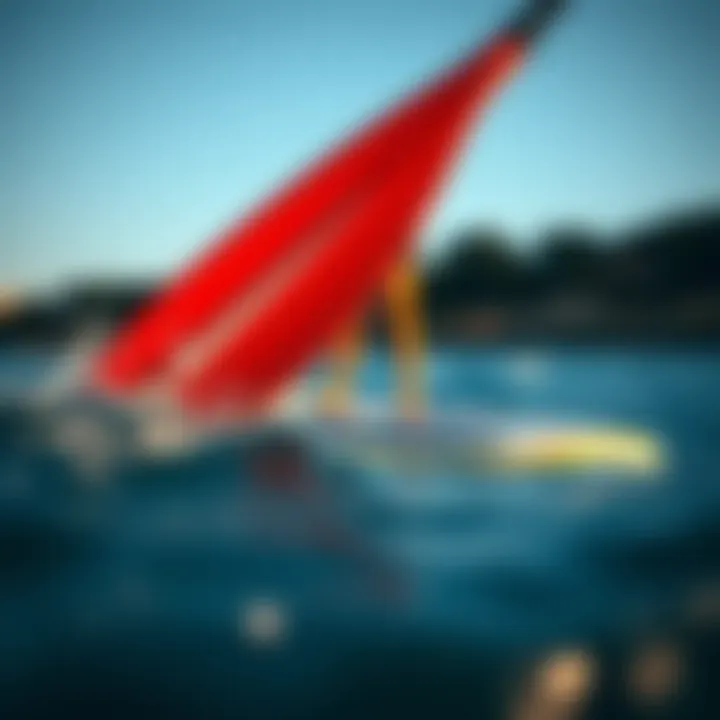
"The right paddle feels less like a tool and more like an extension of your own body."
The Role of Paddles in Paddleboarding
Understanding the role of paddles in paddleboarding extends beyond mere functionality. They serve as the primary means of propulsion, steering, and stability. Whether gliding across calm lakes, tackling ocean waves, or turning swiftly in a narrow river, the paddle's influence directly shapes the experience. From helping to maintain balance to providing the required speed for various activities, a paddle that meshes well with your style is essential. Choosing the right paddle can meaningfully transform each paddleboarding session into not just a workout, but an enjoyable exploration of nature.
Key Considerations When Choosing a SUP Paddle
Understanding the important factors in choosing a SUP paddle goes beyond just picking one off the shelf. It directly affects your paddleboarding experience, making comfort and efficiency a priority. Selecting the right paddle isn't just about aesthetics; it has practical implications that can elevate your time on the water.
Material Choices
Choosing the right material for your paddle can significantly affect performance and durability. Let’s break down the most common materials and how they contribute to overall paddleboarding satisfaction.
Plastic
Plastic paddles are often seen as a dependable choice for beginners. Their key characteristic is affordability, making them accessible for newcomers without intense investment.
- Durability: Plastic is resistant to dings and scrapes, ensuring a longer lifespan with less care.
- Weight: While they can be heavier than other options, this weight offers stability, particularly beneficial for an inexperienced paddler.
However, many find that the extra heft can cause fatigue during longer sessions, which might make it a less ideal choice for seasoned paddlers seeking agility.~
Fiberglass
When it comes to striking a balance between performance and cost, fiberglass paddles shine. One notable feature is their lighter weight compared to plastic options, which can translate into improved agility on the water.
- Performance: Better stiffness than plastic means more efficient power transfer with each stroke.
- Versatility: They cater to a wide range of paddling styles, from casual outings to more challenging paddling.
Yet, it's worth noting fibreglass paddles can be prone to scratches and damage if not handled with care, a trade-off for their increased performance attributes.
Carbon Fiber
Carbon fiber paddles are the crème de la crème in the paddleboarding world. Their core allure is the unbeatable strength-to-weight ratio, making them a favored choice among racing enthusiasts and performance-oriented paddlers.
- Lightweight Perception: A carbon fiber paddle feels almost weightless in hand, which enhances endurance and reduces fatigue.
- Performance Edge: The stiffness allows power to be translated efficiently into movement, making it perfect for maximizing speed.
Of course, such excellence comes at a price—carbon fiber paddles are typically the most expensive, making them an investment that may not suit everyone’s budget.
Paddle Length
Finding the right paddle length is crucial, referring to how the paddle fits your body's dimensions and paddling style.
Height and Weight Considerations
The height and weight of a paddler play notable roles in determining ideal paddle length. A general rule of thumb is that taller individuals need longer paddles. Typically, a paddle length should be between 8 to 10 inches taller than the person’s height.
- Comfort: An appropriately sized paddle enables a smoother stroke and allows you to paddle without straining yourself.
- Control: Using the right paddle length enhances your control over the board, improving overall stability.
However, there are exceptions based on personal paddling style; if you prefer a more aggressive stroke or ride a shorter board, slight adjustments may apply regardless of your height.
Paddling Style Adjustments
Your paddling style can also dictate paddle length. Some paddlers prefer a lower, more elongated stroke, while others might benefit from a more vertical approach.
- Styles: For a performance-focused paddler, a shorter paddle might work better, enhancing responsiveness. Conversely, touring and recreational paddlers might choose longer paddles for effortless gliding.
- Trial and Error: Finding the sweet spot often requires some experimentation; trying a few different lengths can help hone in on what feels best.
Blade Shape and Size
The shape and size of your paddle blade has a significant impact on how well you can maneuver your board.
Surface Area Effect
A larger blade surface area provides incredible power for each stroke, making it appealing for those looking for a good workout. However, more surface area also means increased drag.
- Efficiency: In calm waters, a larger blade can help speed through quickly and with less effort.
- Fatigue: On choppy waters, the drag can be much more taxing on the arms.
A balance can be found in medium-sized blades, which offer a blend of power and endurance.
Directional Control
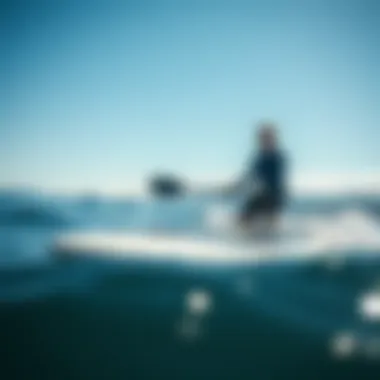
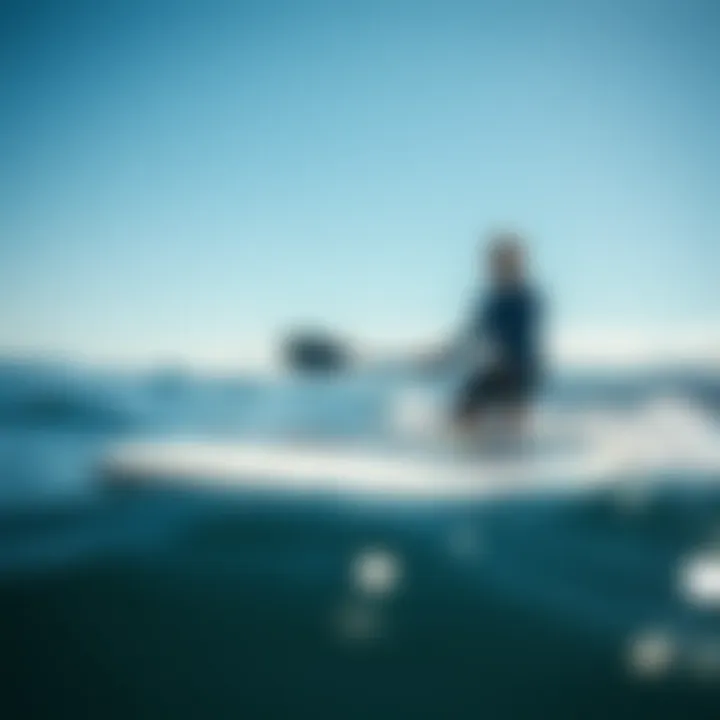
Directional control refers to how effectively you can steer your paddleboard with the blade shape you choose. Wider blades might offer more power, but they can sacrifice maneuverability.
- Tracking: A narrower blade helps with straight-line travel but can lack the vigorous power needed for quick turns.
- Personal Preference: Your unique paddling goals should dictate blade choice here; whether it's agility in racing or sheer power in flat water.
Shaft Flexibility
The flexibility of your paddle shaft can greatly influence both comfort and performance.
Stiffness and Performance
Stiffer shafts generally translate into improved energy transfer; every ounce of effort goes directly into moving the board. For competitive paddlers, this is key.
- Response: Increased responsiveness during strokes allows for rapid speed increases.
- Fatigue: Stiff shafts are not as forgiving, potentially leading to more fatigue over longer periods.
It’s critical to choose a shaft stiffness that matches your paddling capabilities.
Comfort vs. Power Transfer
This consideration involves the balance between comfort while paddling and the need for efficient power transfer. A flexible shaft can absorb shock from strokes, protecting your joints but might not deliver power as effectively.
- Joint Protection: Ideal for long leisure trips where comfort comes first.
- Power Loss: May result in less efficiency during sprints where every bit of power matters.
Carefully weighing these elements helps create a tailored paddling experience designed specifically for you.
Types of SUP Paddles
Understanding the different types of stand-up paddle (SUP) paddles is key for any paddleboarding enthusiast. Each paddle type is designed with specific activities in mind, thus influencing performance, comfort, and overall enjoyment on the water. Choosing the right type not only enhances your paddling experience but can also bolster efficiency and effectiveness depending on what you're planning to do with your SUP.
All-Around Paddles
All-around paddles are your Swiss Army knife of the SUP world. These versatile paddles can handle just about anything, be it cruising on a calm lake or navigating choppy waters. Typically made of lightweight materials like fiberglass or plastic, they offer a good balance of performance and durability. The blades are generally of medium size, catering to various paddling styles.
For beginners or those who want an all-in-one solution, all-around paddles are the way to go. They serve well in both casual and more serious paddling adventures, making them a great option to start with. When selecting an all-around paddle, consider the length and material, which affect both the weight and ease of use. Just remember, a paddle should feel like an extension of your body.
"A great paddler knows that their paddle is more than just a stick; it’s their companion in the adventure ahead."
Touring Paddles
Touring paddles take things a step further, tailored specifically for long-distance paddling. These are generally longer and have a narrower blade, aiming for efficiency with every stroke. The design of a touring paddle allows for less resistance in the water, enabling you to cover more ground with less effort. If exploring coastal waters or embarking on a multi-day paddle adventure, a touring paddle can really enhance your journey.
Durability is often a key factor here. Touring paddles might be made from tougher materials, given they're likely to face more wear and tear on extended trips. Serious paddlers often look for a slightly adjustable shaft length, helping them adjust based on water conditions or fatigue levels. While these paddles are less versatile than all-around ones, they do excel in their niche for those who are serious about long-distance efficiency.
Racing Paddles
For those looking to speed things up, racing paddles are the sport-specific choice. Crafted for advanced performance, racing paddles are generally longer and thinner, allowing paddlers to achieve high speeds. They are typically made from premium materials like carbon fiber, which significantly reduces weight while maintaining strength and stiffness needed for competitive performance.
The blades are designed for rapid entry and exit in the water, minimizing drag for the fastest glide possible. If competition is on your horizon—be it in local races or national competitions—a racing paddle could give you that edge. An important consideration is the fit; these paddles often offer a rigid feel that may take some time to adapt to if you're used to a standard paddle.
Surfing Paddles
Surfing paddles are specifically designed for catching waves. They usually have a shorter shaft and a more robust construction that can withstand the intensity of ocean swells. The blade tends to be wider to get a quick and powerful stroke for sudden take-offs, giving surfers the help they need to paddle into waves effectively.
Many surfers prefer a paddle with a smaller blade to reduce fatigue when waiting for the next wave, while some might opt for a larger blade for that extra push when timing is critical. Furthermore, surf paddles often feature a specific flex that helps absorb shocks from choppy water or crashing waves, ensuring that you remain in control. For those who live for the surf, having the right paddle can make all the difference.
Practical Tips for Selecting the Right Paddle
Selecting the right stand-up paddle (SUP) is not just a matter of picking one out at random. It's an essential step that can elevate your experience on the water. Practical tips can guide you in making an informed choice tailored to your individual needs. A paddle should feel like an extension of yourself, enhancing performance without causing discomfort. Proper research will help ensure that your paddle fits not just your style and purpose, but also your physical characteristics.
Trying Before You Buy
It's always a wise move to test a paddle before you make a financial commitment. Paddle shops often have demo programs that allow you to take a test drive with various models. When you try a paddle, pay attention to how it feels in your hands and during your strokes.
- Weight: A lighter paddle tends to be easier on your arms and shoulders, especially during longer outings.
- Length: This ties into personal preference and your paddling style. A shorter paddle suits those who prefer a quick, high cadence, while a longer paddle can provide more power with each stroke.
- Grip: Ensure the grip feels comfortable. It should not be too thick or thin, as this can cause fatigue over time.
When you're on the water, don’t hesitate to try a stroke or two with different paddles. Every model may have a unique feel that can significantly affect your performance. Remember to check balance too, as that can play a huge role in your overall paddling efficiency.
"Choosing the right paddle is like finding the right pair of shoes; it’s about comfort and performance that suits you."
Balance Between Price and Quality
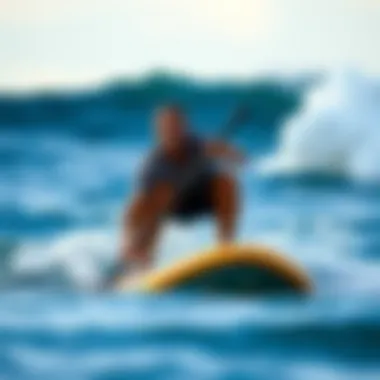
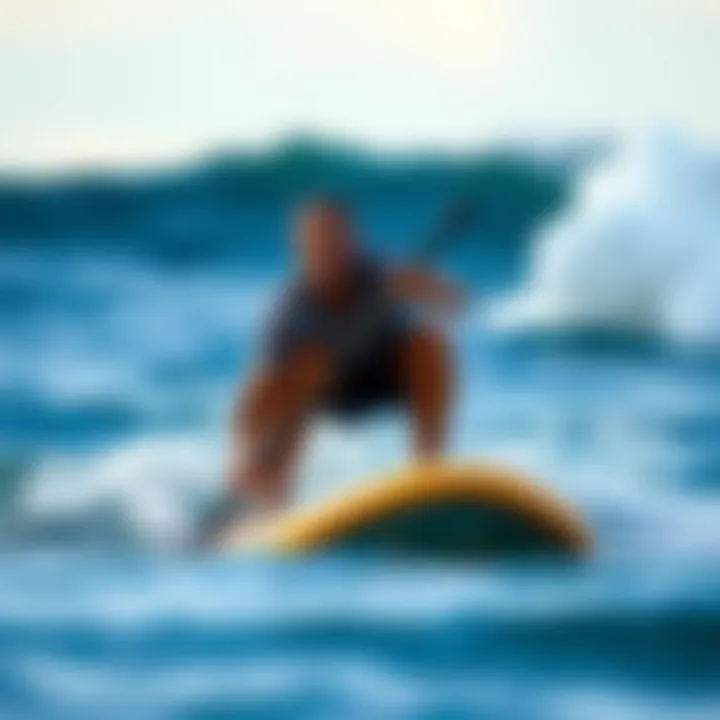
When it comes to purchasing a SUP paddle, the old saying holds true: you get what you pay for. Price often reflects materials, craftsmanship, and brand reputation. However, this does not mean you have to break the bank to get a decent paddle.
- Entry-Level Paddles: If you are just starting out or plan to paddle occasionally, a mid-range paddle made from durable plastic can serve your needs. They offer good performance without the hefty price tag.
- Intermediate Options: As you become more serious, consider investing in a fiberglass paddle. It strikes a fair balance between weight and durability. This choice typically enhances overall paddling performance and comfort.
- Premium Paddles: For advanced users or frequent paddlers, a carbon fiber paddle might be your best bet. While costly, they provide exceptional strength and buoyancy, making them ideal for racing or long-distance touring.
Finding that sweet spot between price and quality often requires some legwork. Assess what features you absolutely need and which ones you can live without. Remember that a paddle is a long-term investment. Don’t settle for anything that feels like a compromise.
Selecting the right paddle is an art, and by employing practical tips like these, you’ll not only save money but also enhance your time on the water.
Explore more about these topics on related platforms like Wikipedia or engage with communities on Reddit.
By taking the time to test out paddles and balancing the price with quality, you'll find a paddle that's just right for you.
Common Mistakes to Avoid
Choosing the right SUP paddle involves careful thought and consideration. However, many enthusiasts often sidestep essential elements that shape their experience on the water. Recognizing common errors can save both time and money, enhancing the paddleboarding journey.
Overlooking Personal Fit
One critical error paddlers make is neglecting to assess how well the paddle fits their body and style. Just like a shoe that’s too tight or too loose can ruin a day out, the same applies to a paddle. If you’re not comfortable holding the paddle, you might strain your back or arms without even noticing until it's too late.
When selecting your paddle, consider your height, weight, and paddling style. A paddle that is too short can lead to inefficient strokes, while one that’s too long might result in discomfort or awkward positioning. Aim to have the paddle height come up to your chin or just under your armpit when standing it on its end. This helps ensure that the paddle matches your build, allowing for a more enjoyable experience.
Additionally, different paddle styles fit various techniques. For instance, a person who prefers a more relaxed paddling style might appreciate a wider blade, while someone inclined towards speed may require a narrower blade. Prioritize finding what feels right for you.
Ignoring the Importance of Maintenance
Another frequent oversight is the neglect of proper maintenance for your SUP paddle. Paddles, much like any other gear, are subject to wear and tear. Ignoring this can lead to diminished performance and even failure in crucial moments.
Here are a few maintenance tips to consider:
- Rinse after use: Saltwater or sand can build up and damage your paddle over time. Rinsing it with fresh water is a quick way to prevent corrosion or buildup.
- Inspect regularly: Look for any cracks, scratches, or loose parts that may affect functionality. Catching these issues early saves you from dealing with a paddle failure on your next outing.
- Store properly: Avoid leaving your paddle in extreme temperatures or direct sunlight, as this can warp materials over time. Keep it in a cool, dry place when not in use.
By incorporating these simple maintenance practices, you can extend the lifespan of your paddle and ensure a better experience on the water.
"A well-maintained paddle is like a trusted friend who always has your back on the water."
These two aspects—personal fit and maintenance—are fundamental in creating a paddleboarding experience that’s just right for you. Being mindful of these areas not only boosts performance but also makes paddling more enjoyable overall.
Emerging Trends in SUP Paddle Technology
As the popularity of paddleboarding grows, so does the innovation in SUP paddle technology. Keeping up with these emerging trends is vital for both enthusiasts and professionals looking to enhance their experience on the water. With significant advancements being made, it becomes easier to select equipment that aligns with personal preferences and performance aspirations.
Innovative Materials
One of the most notable shifts in SUP paddle technology is the introduction of innovative materials that aim to optimize performance while considering weight, durability, and user comfort. For instance, several manufacturers are investing in advanced composites that blend different fibers, resulting in paddles that are lighter and stiffer without compromising strength. An interesting example is the integration of artificial intelligence in designing paddle materials, which helps in crafting blades that boast exceptional hydrodynamics.
Another exciting development is the use of sustainable materials, such as bamboo or recycled plastics. While these materials contribute positively to the environment, they also bring unique performance characteristics. For those passionate about protecting the ocean, opting for an eco-friendly paddle can be a win-win decision.
Smart Paddle Features
The advent of technology has also led to the inclusion of smart features in SUP paddles. Imagine a paddle that can track your strokes, efficiency, and even how long you’ve been on the water. Through smart technology, paddles like those developed by brands such as Kialoa and BOTE come with integrated sensors that can sync with smartphones or fitness trackers. This data offers paddlers insights into their performance that can be invaluable for training and improving technique.
Furthermore, some paddles include GPS capabilities, which can aid in navigation or help paddleboarders explore new routes with ease. These advancements not only enhance the usability of each paddle but also add an element of fun and gamification to paddleboarding. Ignore these trends at your own risk, as they are sure to shape the future of the sport.
"With technology at the helm, paddleboards are set to reach new heights—both in performance and sustainability."
By understanding these emerging trends in SUP paddle technology, users can make informed choices that not only suit their paddling style but also keep them on the cutting edge of equipment innovations. In choosing equipment enriched with these advancements, paddleboarding can evolve into an even more thrilling and satisfying experience.
Closure and Final Thoughts
Choosing the right stand-up paddle (SUP) is more than just picking a piece of equipment; it's about enhancing your entire paddling experience. In this article, we dissected a range of critical factors that come into play when selecting a paddle. From understanding the anatomy of a paddle to recognizing its specific roles across different paddling styles, each detail matters.
Making an Informed Decision
When selecting a paddle, taking an informed approach is paramount. Consider both your environments and your unique paddleboarding goals. Whether you are on a serene lake or tackling ocean waves, the right paddle can significantly impact your performance. Here are key points to mull over:
- Personal Objectives: Are you out for leisure, exercise, or competitive racing? Tailoring your selection to meet your goals is essential.
- Comfort and Fit: A paddle that feels good in your hands and complements your paddling style can mean the difference between an enjoyable day on the water or a backache after a short session.
- Versatility vs. Specialization: Some paddles cater to a myriad of paddling styles, while others are designed for specific sports like surfing or racing. Think about where you plan to spend most of your time.
- Price vs. Quality: Your budget will play a role, but remember, investing in quality gear often pays off in durability and performance.
Encouragement to Explore
Diving into the world of SUP paddles is an adventure in itself. The sheer variety available means that there is a paddle out there that fits your every need. Don’t shy away from experimentation—trying out different styles, lengths, and materials can lead you to discover what you truly enjoy.
"Adventuring is about getting out of your comfort zone, and that includes trying new equipment."
Engage with your local paddleboarding community or explore online forums like Reddit or dedicated Facebook groups. Sharing experiences with fellow enthusiasts helps you grasp what others find beneficial in their paddling endeavors. Remember, every expert was once a beginner, and learning from each other enriches the Paddleboarding culture.
In the end, selecting your ideal SUP paddle isn't merely a checklist of specifications but a journey towards enhancing your time on the water. Embrace the process, do your research, and keep paddling!



